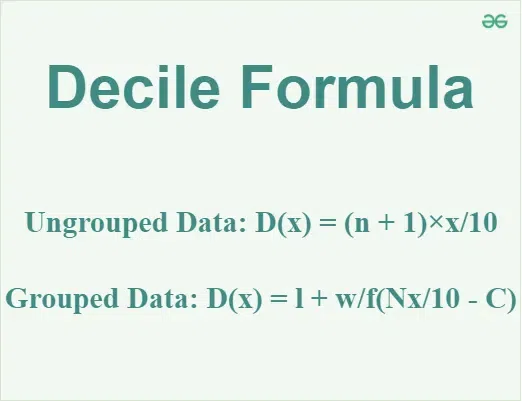
|
|
Decile is a statistical measure that divides a dataset into ten equal parts, and each part contains 10% of the data. It is different from percentage as in percentage there are 100 parts. In this article, we will learn in detail about what is decile, the formulas of decile (grouped data and ungrouped data) Table of Content What is Decile?A decile is a quantitative method of dividing data into 10 equal parts. Suppose there is a list of numbers, then the data in the list can be put in order from smallest to largest, and then split into 10 groups with an equal number of numbers in each group. This method is often used in finance and economics studies to help understand and analyze data. Deciles are different from percentiles, and quintiles quartiles, which divide data into 100 parts, 4 parts, and 5 parts respectively. Definition of Decile
This arrangement of data is done on a scale of 1 to 10, where each step represents an increase of 10 percentage points. Formula of DecileDecile has two ways to be calculated based on the type of data.  Formula of Decile The two formulas to calculate decile are:
Decile Formula for Ungrouped DataTo find the decile for ungrouped data, first, the data needs to be arranged in ascending order. Then, the following formula is applied:
where,
Decile Formula for Grouped DataTo calculate the decile of a grouped data, cumulative frequency is used. The formula to find the decile of a grouped date is as follows:
where,
Decile Class RankDecile class rank refers to a method of ranking students based on their academic performance relative to their peers within their class. The class is divided into ten equal parts or “deciles,” with each decile representing 10% of the class. How to Calculate Decile?Calculate the decile of any given set of data following the steps given below: Sort the Data: Arrange the data points in ascending order from smallest to largest. Identify Decile Number: Decide which decile you want to find (e.g., 1st decile, 2nd decile, etc.). Calculate Position: For ungrouped data, use the formula:
Where:
Find the Value: Once you have the position, locate the corresponding value in the sorted data set. This value represents the decile. Examples of DecileFor example, Suppose we have a data set consisting of the following numbers representing the scores of students in a math test: 65, 72, 84, 57, 68, 75, 80, 92, 88, 78, 60, 70, 85, 95, 62, 73, 79, 83, 90, 77.
Solved Examples on DecileExample 1: Given the following grouped data representing the scores of students in a class:
Find the first decile for this data. Solution: First we will calculate the cumulative Frequency
Total number of observations (N) = 5 + 8 + 12 + 15 + 10 = 50 Position of Decile D1 = N/10 = 50/10 = 5 Now, cumulative frequency just greater than D1 is corresponding to the score range 11-20 Now we know, that for ungrouped data
where,
Putting the values in the formula we get, D1 = 11 + [Tex]\left( \frac{5 – 5}{8} \right)[/Tex] × 10 D1 = 11 + (0/8) × 10 D1 = 11 + 0 × 10 ∴ D1 = 11 Example 2: Given the following ungrouped data representing the ages of ten individuals: 22,25,30,33,35,40,45,50,55,60. Find the deciles for this data. Solution:
Practice Questions on DecileQ1. Calculate the value of the 3rd decile for the following set of data: 12, 15, 18, 20, 22, 25, 28, 30, 32, 35. Q2. Given the cumulative frequency distribution below, determine the value of the 7th decile:
Q3. Determine the 5th decile for the following set of data 18, 22, 25, 30, 35, 40, 45, 50, 55, 60. Q4. The following data represents the marks obtained by 60 students in a test:
Determine the value of the 9th decile. FAQs of DecileWhat is Decile Rank?
What is a first decile and second decile?
What is the difference between decile and percentage?
What does 90% decile mean?
|
Reffered: https://www.geeksforgeeks.org
| Mathematics |
Type: | Geek |
Category: | Coding |
Sub Category: | Tutorial |
Uploaded by: | Admin |
Views: | 14 |